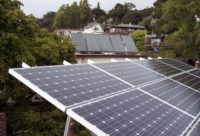PacifiCorp plans to significantly increase solar and wind energy generation alongside a phased retirement of 20 of its 24 coal units and add battery storage for the first time, according to the utility’s draft 20-year plan.
“This plan allows us to continue to deliver the reliable and low-cost energy our customers need as we embark on a phased and well-managed coal transition that minimizes impacts to our thermal operations workforce and communities,” said Rick Link, vice president of resource planning and acquisitions for PacifiCorp, which operates in six western states.
The Sierra Club, however, says that PacifiCorp’s own data shows a faster transition to renewables could be cheaper, while the state legislature in Wyoming is pushing for the utility to sell, rather than retire, the plants.
The 20-year integrated resource plan, which will be filed Oct. 18 with state utility commissions in Oregon, Washington, California, Utah, Wyoming and Idaho, proposes 3,500 MW of new wind and almost 3,000 MW of new solar capacity by 2025. That increases to at least 4,600 MW of new wind and 6,300 MW of new solar by 2038. By 2025, 600 MW of battery storage capacity will be paired with solar. There will be 2,800 MW of battery storage by 2038, including 1,400 MW of stand-alone storage beginning in 2028. PacifiCorp is also planning to construct a 400-mile, estimated $1.8-billion transmission line, the Gateway South, between Wyoming and Utah. It’s scheduled to be complete and in service by 2023. The line, federally permitted and sited in 2016, is currently going through the state and local permitting process.
PacifiCorp plans to issue an all-source request for proposals for wind projects by the end of the second quarter next year. Wind capacity is likely to be added early, to qualify the projects for the final year of the wind production tax credit in 2023, available then at a 40% reduced credit rate, according to PacifiCorp spokesman Bob Gravely. The new wind projects are expected to be worth more than $2 billion, he says.
About three-fourths of planned wind capacity will come from projects in Wyoming, including 1,500 MW currently under construction and set to be completed in 2020. PacifiCorps will also close down 11 coal-fired power units in Wyoming between 2019 and 2037, including Naughton 3, which will be converted into a natural gas plant next year.
A bill passed by the Wyoming legislature in March and signed into law might stymie those closures. Under the measure, utilities must attempt a “good faith effort” to sell a coal plant before retiring it, or otherwise be prevented from adding recovery of costs to ratepayer charges. “Wyoming leadership is trying to put up resistance to PacifiCorp’s plans to look at early coal plant closures,” says Christopher Thomas, a senior campaign representative of the Sierra Club. “Our hope would be that instead of just focusing on trying to stop the economic trends that are happening, focus more on what is going to help these affected communities transition.”
Gravely, however, says the law hasn’t impacted PacifiCorp’s planning process. Currently, coal accounts for about 56% of PacifiCorp’s utility mix. Natural gas makes up 15%, and wind and solar 9% and 4%, respectively.
While encouraged by PacifiCorp’s renewable energy plans, Thomas says the utility “is slow walking coal plant retirements despite spending the last year showing how much money it can save customers with a speedier transition.” Thomas points to other utilities in the region with ambitious carbon reduction timelines, such as Colorado’s Xcel Energy, which plans to be 80% carbon-free by 2030 and 100% by 2050.
PacifiCorp produced a report in 2018, ordered by the Oregon Public Utilities Commission, on the economics of keeping coal plants open past 2022.
The report showed that more than half of PacifiCorp’s coal units produced more expensive power than alternatives. But Gravely says the economics extend beyond a comparison of the costs of coal to renewables. “When you look at the full spectrum of inputs that the IRP process does, it showed that it just wasn’t really viable to retire that many units in 2022 without significantly increasing the costs of the replacement resources.”





Post a comment to this article
Report Abusive Comment